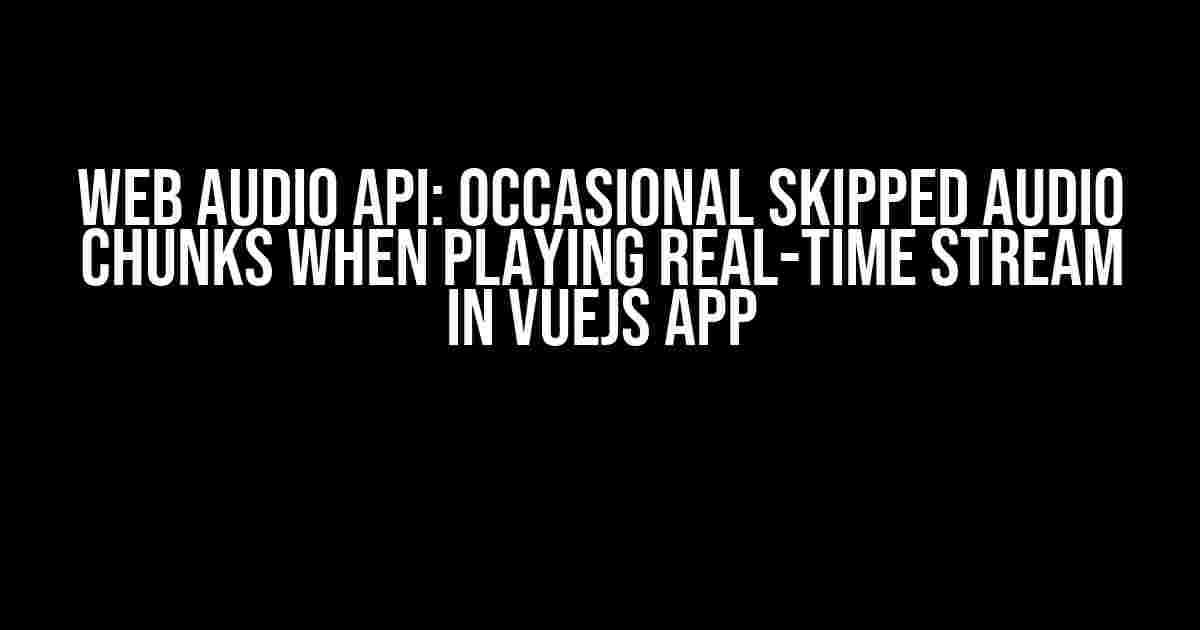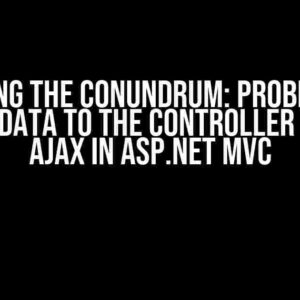Are you tired of dealing with frustrating audio skipping issues in your VueJS application? Are you struggling to find a solution to the problem of occasional skipped audio chunks when playing real-time streams using the Web Audio API? Look no further! In this comprehensive guide, we’ll dive into the world of web audio and provide you with clear, direct instructions on how to overcome this pesky problem.
Understanding the Web Audio API
The Web Audio API is a powerful tool for creating and manipulating audio in the browser. It provides a high-level API for processing and synthesizing audio, allowing developers to create complex audio applications with ease. However, with great power comes great complexity, and the Web Audio API is no exception.
One of the most common issues developers face when working with the Web Audio API is the problem of occasional skipped audio chunks when playing real-time streams. This issue can be caused by a variety of factors, including:
- Insufficient buffer sizes
- Inadequate system resources
- Network congestion or packet loss
- Incorrect audio format or encoding
Diagnosing the Problem
Before we dive into the solution, let’s take a step back and diagnose the problem. To do this, we’ll need to gather more information about the audio stream and the Web Audio API context.
Here are some questions to ask yourself:
- What is the audio format and encoding used in the stream?
- What is the buffer size and sample rate of the audio context?
- Are there any errors or warnings in the console related to the Web Audio API?
- Is the audio stream being played in real-time, or is it being buffered?
Solution 1: Increase the Buffer Size
One of the most common causes of skipped audio chunks is an insufficient buffer size. The buffer size determines how much audio data is stored in memory before it’s played. If the buffer size is too small, the audio context may not have enough data to play, resulting in skipped chunks.
To increase the buffer size, you can modify the audio context’s buffer size property:
const audioContext = new AudioContext();
audioContext.bufferSize = 4096;In this example, we’re setting the buffer size to 4096 samples. You can adjust this value based on your specific needs and the requirements of your application.
Solution 2: Use a More Efficient Audio Format
The audio format and encoding used in the stream can also affect the performance of the Web Audio API. Some audio formats, such as PCM, can be computationally intensive and may cause skipped audio chunks.
One solution is to use a more efficient audio format, such as Opus or AAC. These formats are designed to be more compact and efficient, reducing the computational load on the system.
Here’s an example of how to decode an Opus audio stream using the Web Audio API:
const audioContext = new AudioContext();
const source = audioContext.createBufferSource();
const opusDecoder = new OpusDecoder();
opusDecoder.ondecode = (event) => {
const audioBuffer = event.detail.audioBuffer;
source.buffer = audioBuffer;
source.connect(audioContext.destination);
source.start();
};Solution 3: Implement Error Handling and Retry Mechanisms
Network congestion or packet loss can also cause skipped audio chunks. To mitigate this issue, you can implement error handling and retry mechanisms to ensure that the audio stream is played smoothly.
Here’s an example of how to implement a retry mechanism using VueJS:
<template>
<div>
<audio :src="audioSrc" @error="handleError"></audio>
</div>
</template>
<script>
export default {
data() {
return {
audioSrc: '',
retryCount: 0,
};
},
methods: {
handleError(event) {
if (this.retryCount < 3) {
this.retryCount++;
this.audioSrc = `${this.audioSrc}?retry=${this.retryCount}`;
} else {
console.error('Error playing audio stream');
}
},
},
};
</script>In this example, we’re using the `@error` event to detect when an error occurs while playing the audio stream. We then increment a retry count and update the audio source URL with a retry parameter. This allows us to retry playing the audio stream up to three times before giving up.
Solution 4: Optimize System Resources
Inadequate system resources can also cause skipped audio chunks. To optimize system resources, you can:
- Close unnecessary tabs or applications
- Upgrade your system’s RAM or CPU
- Use a more efficient browser or device
Additionally, you can optimize your VueJS application by:
- Using lazy loading or code splitting to reduce the initial load size
- Optimizing images and assets using compression tools
- Minifying and uglifying your code
Conclusion
In this article, we’ve explored the problem of occasional skipped audio chunks when playing real-time streams using the Web Audio API in a VueJS application. We’ve diagnosed the problem, and provided four solutions to overcome this issue:
- Increase the buffer size
- Use a more efficient audio format
- Implement error handling and retry mechanisms
- Optimize system resources
By following these solutions, you should be able to overcome the problem of skipped audio chunks and provide a smooth and seamless audio experience for your users.
| Solution | Description |
|---|---|
| Increase Buffer Size | Modify the buffer size property to store more audio data |
| Use Efficient Audio Format | Use formats like Opus or AAC to reduce computational load |
| Error Handling and Retry | Implement retry mechanisms to handle network congestion or packet loss |
| Optimize System Resources | Close unnecessary tabs, upgrade system resources, or use efficient browsers |
Remember, the key to overcoming skipped audio chunks is to understand the underlying causes of the problem and implement targeted solutions to address them. By following the solutions outlined in this article, you’ll be well on your way to creating a seamless and engaging audio experience for your users.
Frequently Asked Question
Having trouble with skipped audio chunks in your VueJS app? Don’t worry, we’ve got you covered! Here are some frequently asked questions and answers about Web Audio API and real-time stream issues.
Why am I experiencing occasional skipped audio chunks when playing a real-time stream in my VueJS app?
This could be due to the Web Audio API’s buffering mechanism. When the browser receives audio data faster than it can be processed, it may skip chunks to avoid buffer overflow. To mitigate this, you can try adjusting the buffer size or implementing a more efficient audio processing pipeline.
How can I optimize my audio processing pipeline to reduce skipped chunks?
You can try implementing a more efficient audio processing pipeline by using Web Workers to offload computationally expensive tasks, optimizing your audio decoding and encoding algorithms, and leveraging caching mechanisms to reduce the load on the main thread.
Are there any VueJS-specific considerations I should be aware of when dealing with Web Audio API?
Yes, in VueJS, you’ll want to ensure that you’re not blocking the main thread with computationally expensive tasks, as this can cause the audio pipeline to stall and lead to skipped chunks. Use Vue’s built-in async/await syntax and Web Workers to keep your audio processing off the main thread.
Can I use existing libraries to simplify my audio processing pipeline?
Yes, there are several libraries available that can help simplify your audio processing pipeline, such as plex, which provides a high-level API for working with audio in the browser, or aurelia-sound, which offers a more lightweight solution for audio processing in VueJS apps.
What are some common pitfalls to avoid when implementing Web Audio API in my VueJS app?
Some common pitfalls to avoid include not properly handling audio context suspension and resumption, failing to account for audio clock drift, and not implementing proper error handling and fallback mechanisms for when the audio pipeline fails.


